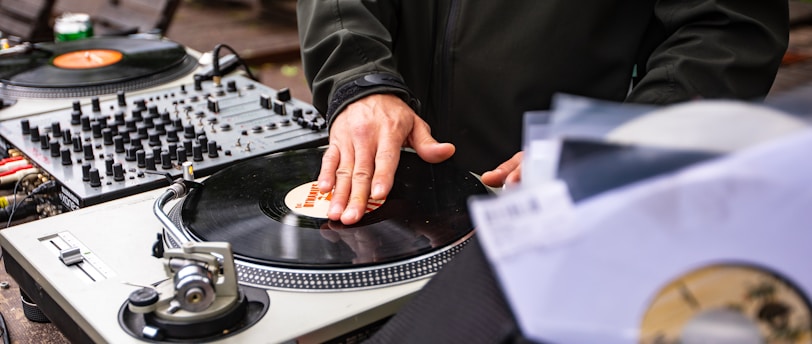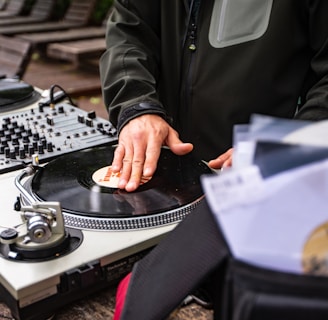The Sync Button Debate: Exploring Different Mixing Techniques


The Sync Button: A Controversial Tool in the DJ World
In the world of DJing, there's a tool that has sparked a heated debate among professionals and enthusiasts alike - the sync button. This small, innocuous button on modern DJ controllers and software has revolutionized the way DJs mix their tracks, but it has also raised questions about the essence of DJing and the skill required to create seamless transitions.
Manual Beatmatching: The Traditional Approach
Before the advent of the sync button, DJs relied on their ears and their skills in manual beatmatching to create smooth transitions between tracks. This technique involves carefully adjusting the speed and pitch of two tracks to match their beats, ensuring a seamless flow of music. Manual beatmatching requires a keen sense of rhythm, a deep understanding of music structure, and hours of practice to master.
Many purists argue that manual beatmatching is the true art of DJing. They believe that relying on the sync button takes away from the skill and creativity required to mix tracks. For them, the ability to flawlessly match beats by ear is what sets a great DJ apart from the rest.
The Advantages of Manual Beatmatching
One of the main advantages of manual beatmatching is the level of control it gives DJs over their mixes. By manually adjusting the speed and pitch of tracks, DJs have the freedom to create unique transitions and manipulate the energy of the dancefloor. This hands-on approach allows for greater creativity and spontaneity in the mix.
Manual beatmatching also helps DJs develop a deeper understanding of music. By closely listening to the nuances of each track, DJs become more attuned to the intricacies of rhythm and timing. This heightened awareness can enhance their overall musicality and enable them to make more informed track selections.
The Disadvantages of Manual Beatmatching
While manual beatmatching offers a level of control and creativity, it also requires a significant amount of time and practice to master. DJs who choose this approach must invest countless hours honing their skills and developing their ear for rhythm. This commitment to manual beatmatching can be a barrier for aspiring DJs who are eager to start performing but may not have the luxury of dedicating extensive time to practice.
Additionally, manual beatmatching is not foolproof. Even the most skilled DJs can make mistakes, resulting in awkward transitions or trainwreck mixes. This can be especially challenging in high-pressure environments such as live performances or radio sets, where there is little room for error.
The Sync Button: A Technological Aid
Enter the sync button - a feature that has become a staple in modern DJ equipment and software. With a simple press of a button, DJs can automatically synchronize the beats of two tracks, eliminating the need for manual beatmatching. This technological aid has undoubtedly made DJing more accessible to newcomers and has streamlined the mixing process.
The Advantages of the Sync Button
One of the most obvious advantages of the sync button is its efficiency. DJs can quickly match the beats of two tracks, saving time and allowing them to focus on other aspects of their performance, such as track selection and crowd interaction. This efficiency can be particularly beneficial in fast-paced genres like techno or drum and bass, where tracks often have complex rhythms and rapid tempo changes.
Furthermore, the sync button can serve as a useful tool for DJs who want to experiment with complex mixing techniques. By automating the beatmatching process, DJs can explore intricate layering, looping, and effects manipulation, pushing the boundaries of their creativity.
The Disadvantages of the Sync Button
Detractors of the sync button argue that it diminishes the skill and artistry of DJing. They believe that relying on technology to match beats takes away from the human element and the personal touch that manual beatmatching brings to a mix. Critics argue that DJs who rely solely on the sync button are simply playing a pre-selected playlist, rather than actively engaging with the music and the crowd.
Another disadvantage of the sync button is its potential to create a homogeneous sound. When tracks are perfectly beatmatched, the transitions can sound too seamless and robotic, lacking the natural ebb and flow that manual beatmatching brings. Some DJs argue that imperfections and slight variations in beatmatching create a more organic and dynamic listening experience.
Exploring Different Perspectives
It's important to note that the debate surrounding the sync button is not black and white. There are DJs who embrace both manual beatmatching and the sync button, using them as complementary tools to enhance their performances.
Experienced DJs who have mastered manual beatmatching often view the sync button as a backup or safety net. They rely on their skills but appreciate the convenience and efficiency that the sync button offers in certain situations. For them, it's about striking a balance between tradition and technology.
On the other hand, DJs who primarily use the sync button emphasize the importance of track selection, creative mixing techniques, and crowd engagement. They argue that DJing is not solely about beatmatching but about curating a unique and memorable experience for the audience.
Reflecting on Your Own Methodology
Whether you're a seasoned DJ or just starting your journey, the sync button debate invites you to reflect on your own methodology. Consider your goals as a DJ, the genres you play, and the type of audience you want to connect with.
If you're passionate about the art of manual beatmatching, dedicate time to practice and refine your skills. Embrace the challenge and the sense of accomplishment that comes with mastering this traditional technique.
Alternatively, if you're drawn to the efficiency and creative possibilities of the sync button, explore different mixing techniques and experiment with the tools at your disposal. Remember that DJing is an ever-evolving art form, and there's no one-size-fits-all approach.
Conclusion
The sync button debate in the DJ world is an ongoing conversation that highlights the evolving nature of DJing and the impact of technology on the craft. While manual beatmatching and the sync button offer distinct advantages and disadvantages, it's ultimately up to each DJ to decide which approach aligns with their artistic vision and goals.
Whether you choose to embrace the tradition of manual beatmatching or leverage the efficiency of the sync button, the most important aspect of DJing is the ability to connect with the music and the audience. After all, it's the passion and creativity behind the decks that truly sets a DJ apart.
